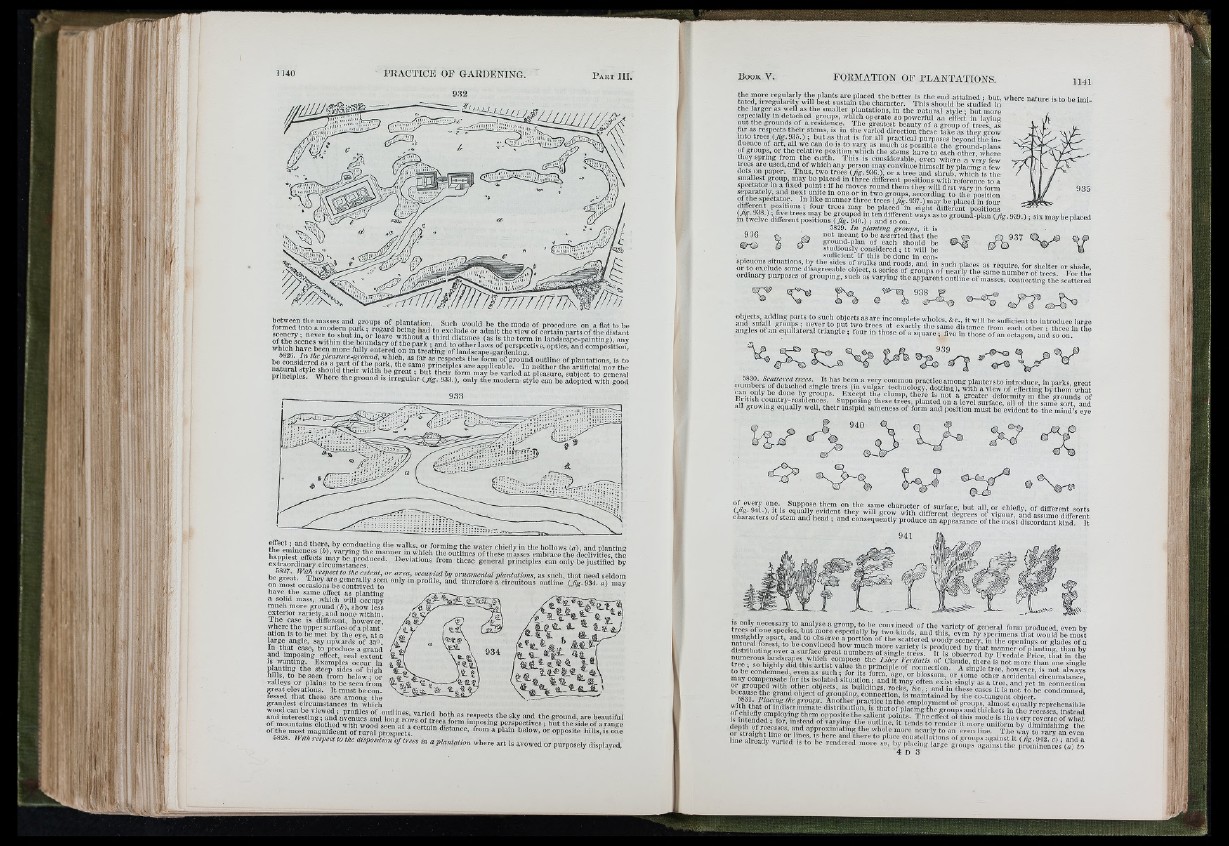
ti ’
u
'Ti'
ic> h-
' ^ ji
to hi
| i
'l '
fe'
I tih
¥ ' T
1 ;l; '
: « i; li
1 ' ’! , : M
^ r im 7 V /7 7 ? W M
o n h l r e e £ s l i tM ] th . «'"■'I distance (as Is th e tern, in lanilscape-painting), any
principies] Where thl’g lo 'S sE rS irrife S ^
S ¥ £ d i ] 5 f c i r ¥ S ] E a n ¥ e s “ "»'''•■“ ■»‘»i f '™ U-ese general principles can only be justified by
\ f ”“' "’■ " t o ' ta “ ?;«'* + / ornamental plantaticns, as sneh, that need seldom
oS m S o c c ^ K be co^^^^^^^^^^ " therefore a circuitous outline'44.......at, uvu.taiuiis ue coiiirivea to ( ,* .9 3 4 .» ) may
have the same effect as planting
a solid mass, which will occupy
much more ground (b), show less
^ t e n o r variety, aud none within.
The case is different, however,
where the upper surface of a plant •
ation is to be met by the eye, a t a
large angle, say upwards of .33°.
In th a t case, to produce a grand
and imposing effect, real extent
IS wanting. Examples occur in ft S '
planting the steep sides of high
hills, to be seen from below ; or
valleys or plains to be seen from
great elevations. It must be con.
fessed that these are among the
grandest circumstances in wiiich
and int™estin^Ta^i?d’a ? e n u S a n d™ n fe reW l? f* tip S ? the sky and the ground, are beautiful
of mountains clothed with w o X e S a c m r i ^ miposing perepectives ; but the side of a range
of the most magnificent of rural prospStS distance, from a plain below, or opposite hills, is one
5828. r r ,ii reepectto IM dtspo.it,On oftrees in a plantation where a rt is avowed or purpo.ely displayed.
the more regularly the plants are placed the better Is the end attained ; but, where nature is to be imi
t.^ed, irregularity will best sustain the character. This should be studied in
the larger _as well as the smaller plantations, in the natura l style ; but more
especially in detached groups, which operate so powerful an effect in laving
out the grounds of a residence. The greatest beauty of a group of trees as
ffoarr a. !s rre.!snp.refcotcs rthe»ei,rr csrteeymvsse , fiso fo the Varied direction these take as they grew
into trees ( / ...................
fluence of ai
■.935.); but as th at is for all practical purposes beyond the in-
T r ? ra-ft much as possible the ground-plans
of groups, or the relative position which the stem sliav e to e L h T th L where
tliey spring from the ea rth. This is considerable, even where a very few
trees are used, and of which any person may convince himself by placing a few
dots on paper. I h u ^ two trees (fig. 93G.X or a tree and shrub, which is the
smallest group, may be placed m three different positions with reference to a
spectator in a fixed p o in t: if he moves round them they will first vary in form
separately, and next unite in one or in two groups, according to the position
o fth e spectator. In like manner three trees ( fixr 037.)may be placed in four
935
Positimis ; fofer treefemay "be" \T a redV T ig h™ Jife renT 7 o sftira
(fig. 938.); five trees^may be p o u p e d m ten different ways as to ground-plan (Jig. 939.); six may be placed
in twelve different positions (
940.) ; and so o...
936 (
I n planting groups, it is
not meant to be asserted th at the
ground-plan of each should be
studiously considered ; it i
............. OT.„. ......... __ ,.ill Ijg
sufficient'if this be done in con-
spicuous situations, by the sides of walks and roads, and in such places as require for shelter or shade
938
939
fe coiumon practice among planters to introduce, in parks great
••m S iT d fe ftchnoftgy: dotting), with a view of effecting by them what
f L - ? by groups. Except th e clump, there is not a greater deformity in the grounds of
British country-residences. Supposing these trees, planted on a level surface, all of the same sort and
all growing equally well, th e ir insipid sameness of form and position must be evident to the mind’s eye
is only necessary^ to .analyse a group, to be convinced of the variety of general form nrodoccd even
d f s S tf e ^ j
s or glades of a
distributing over a S r„gY e ”S s ' . “ i” “ K J r * C S l f
with that of
Ts i n 3 e r & ] S , ? a T ' I” !"“ - The efffct o fth is mode fs t i e re fy re fe r s eY f f e ] ]
‘« ’i
¥ ''1 !
; i l l